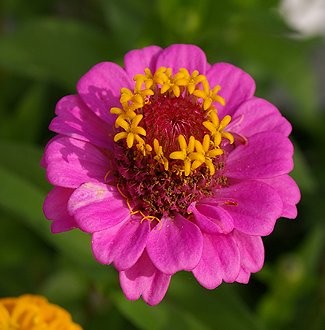Zinnia elegans |
| PlantFile Report |
Copyright © 2000 - 2025 Peter Kirkland - www.plantfile.com |
Plant Profile |
|
| Plant |
| ID |
|
305 |
 |
| Botanic Name |
|
Zinnia elegans |
| Common Name |
|
Zinnia, Youth and Old Age |
| Family Name |
|
Asteraceae |
| Cultivars |
|
'Californian Giants','Dahlia-flowered','Gold Medal','Brilliant Giants','Scarlet Ruffles','Burpeeana Super Giant','Carousel','Envy','Fantasy','Sprite','Buttons','Lilliput','Peter Pan','Tetra Ruffled','Thumbelina' |
| Origin |
|
Mexico, Zone 8-11 |
| Growth Type |
|
Annual |
| Bark Type |
|
Soft wooded |
| Foliage Type |
|
Herbacious |
Water Use |
|
Medium |
| No. of Species |
|
20 |
| Growth Habit |
|
Spreading-ascending |
Growth Rate |
|
Fast |
| Height |
|
0.6 - 1 m (2 - 3 ft) |
Spread |
|
0.4 m (1 ft) |
| Plant Overview |
|
This annual has an upright habit with slender stems that form a bushy habit. It has mid green ovate leaves and the large radiate flowers are avaliable in many colours white, pink, red, lavender and apricot appearing throughout summer above the foliage. |
|
| Leaf |
| Type |
|
Simple |
|
Additional Information |
| Shape |
|
Ovate |
|
The mid green leaves are ovate to lanceolate and clasp the stem at the base and are up to 90 mm (3 ½ in) long. They are arranged decussate along the stems. |
| Arrangement |
|
Opposite |
| Margin |
|
Entire |
| Colour |
|
Mid green |
| Size |
|
70 - 90 mm ( 2.8 - 3.5 in ) |
|
| Flower |
| Perfume |
|
Odorless |
|
Additional Information |
| Shape |
|
Tubulate |
|
The flowers are single or double with overlapping ray florets and are up to 200 mm (7 ¾ in) wide They are available in a variety of colours and appear from late spring to autumn. |
| Inflorescence |
|
Capitulum |
| Colour |
|
Red - yellow |
| Size |
|
100 - 200 mm ( 3.9 - 7.9 in ) |
|
Flowering in (Southern Hemisphere)
|
|
| Jan |
Feb |
Mar |
Apr |
May |
Jun |
| Jul |
Aug |
Sep |
Oct |
Nov |
Dec |
|
|
| Fruit |
| Type |
|
Cypsela |
|
Additional Information |
| Colour |
|
Brown |
|
The large cultivars produce 100 seeds per gram and the small cultivars have 200 - 400 seeds per gram. The seeds are viable but may not produce plants true to form. |
| Edible |
|
No |
| Bird Attractive |
|
No |
| Size |
|
0 - 0 mm ( 0.0 - 0.0 in ) |
|
Fruiting in (Southern Hemisphere)
|
|
| Jan |
Feb |
Mar |
Apr |
May |
Jun |
| Jul |
Aug |
Sep |
Oct |
Nov |
Dec |
|
|
| Environment & Cultivation |
| Natural Soil |
|
Well drained sandy to clay loam friable, moist and fertile, pH 5.5-7.5 |
| Container |
|
Pots, tubs, planter boxes |
| Climate |
|
Warm temperate |
| Aspect |
|
Full sun, wind and humidity protection, drought and frost tender |
| Pest & Diseases |
|
Aphids, budworm, thrips, catepillars, slugs, spider mites, japanese beetle |
| Fertiliser |
|
Added rotted compost and liquid fertiliser at fortnightly intervals, keep moist. |
| Pruning |
|
Tip pruned during growing period, remove spent flowers |
| Cultural Uses |
|
Propagation |
|
Zinnia elegans is grown for its flowers and is planted in small or cottage gardens along low borders or mass planted in bedding displays in parks or public places. It is suitable for coastal or inland regions and establishes in one season.
|
|
Sow fresh seeds in warm areas during early spring and in cool areas during mid-spring to early summer in boxes under glass. Pricked out when large enough to handle and pot up or plant out. It takes 12 weeks to produce flowers from seeds. |
|
|